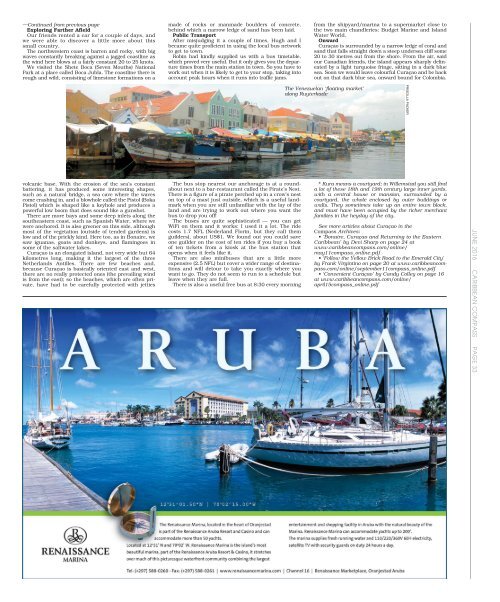Caribbean Compass Yachting Magazine June 2016
Welcome to Caribbean Compass, the most widely-read boating publication in the Caribbean! THE MOST NEWS YOU CAN USE - feature articles on cruising destinations, regattas, environment, events...
Welcome to Caribbean Compass, the most widely-read boating publication in the Caribbean! THE MOST NEWS YOU CAN USE - feature articles on cruising destinations, regattas, environment, events...
Create successful ePaper yourself
Turn your PDF publications into a flip-book with our unique Google optimized e-Paper software.
— Continued from previous page<br />
Exploring Farther Afield<br />
Our friends rented a car for a couple of days, and<br />
we were able to discover a little more about this<br />
small country.<br />
The northwestern coast is barren and rocky, with big<br />
waves constantly breaking against a jagged coastline as<br />
the wind here blows at a fairly constant 20 to 25 knots.<br />
We visited the Shete Boca (Seven Mouths) National<br />
Park at a place called Boca Jubla. The coastline there is<br />
rough and wild, consisting of limestone formations on a<br />
made of rocks or manmade boulders of concrete,<br />
behind which a narrow ledge of sand has been laid.<br />
Public Transport<br />
After misjudging it a couple of times, Hugh and I<br />
became quite proficient in using the local bus network<br />
to get to town.<br />
Robin had kindly supplied us with a bus timetable,<br />
which proved very useful. But it only gives you the departure<br />
times from the main station in town. So you have to<br />
work out when it is likely to get to your stop, taking into<br />
account peak hours when it runs into traffic jams.<br />
from the shipyard/marina to a supermarket close to<br />
the two main chandleries: Budget Marine and Island<br />
Water World.<br />
Onward<br />
Curaçao is surrounded by a narrow ledge of coral and<br />
sand that falls straight down a steep undersea cliff some<br />
20 to 30 metres out from the shore. From the air, said<br />
our Canadian friends, the island appears sharply delineated<br />
by a light turquoise fringe, sitting in a dark blue<br />
sea. Soon we would leave colourful Curaçao and be back<br />
out on that dark blue sea, onward bound for Colombia.<br />
The Venezuelan ‘floating market’<br />
along Ruyterkade<br />
PRISCILLA PACKER<br />
volcanic base. With the erosion of the sea’s constant<br />
battering, it has produced some interesting shapes,<br />
such as a natural bridge, a sea cave where the waves<br />
come crashing in, and a blowhole called the Pistol (Boka<br />
Pistol) which is shaped like a keyhole and produces a<br />
powerful low boom that does sound like a gunshot.<br />
There are more bays and some deep inlets along the<br />
southeastern coast, such as Spanish Water, where we<br />
were anchored. It is also greener on this side, although<br />
most of the vegetation (outside of tended gardens) is<br />
low and of the prickly kind. Here too, as in Bonaire, we<br />
saw iguanas, goats and donkeys, and flamingoes in<br />
some of the saltwater lakes.<br />
Curaçao is an elongated island, not very wide but 64<br />
kilometres long, making it the largest of the three<br />
Netherlands Antilles. There are few beaches and,<br />
because Curaçao is basically oriented east and west,<br />
there are no really protected ones (the prevailing wind<br />
is from the east); so the beaches, which are often private,<br />
have had to be carefully protected with jetties<br />
The bus stop nearest our anchorage is at a roundabout<br />
next to a bar-restaurant called the Pirate’s Nest.<br />
There is a figure of a pirate perched up in a crow’s nest<br />
on top of a mast just outside, which is a useful landmark<br />
when you are still unfamiliar with the lay of the<br />
land and are trying to work out where you want the<br />
bus to drop you off!<br />
The buses are quite sophisticated — you can get<br />
WiFi on them and it works: I used it a lot. The ride<br />
costs 1.7 NFL (Nederland Florin, but they call them<br />
guilders), about US$1. We found out you could save<br />
one guilder on the cost of ten rides if you buy a book<br />
of ten tickets from a kiosk at the bus station that<br />
opens when it feels like it.<br />
There are also minibuses that are a little more<br />
expensive (2.5 NFL) but cover a wider range of destinations<br />
and will detour to take you exactly where you<br />
want to go. They do not seem to run to a schedule but<br />
leave when they are full.<br />
There is also a useful free bus at 8:30 every morning<br />
* Kura means a courtyard: in Willemstad you still find<br />
a lot of these 18th and 19th century large inner yards,<br />
with a central house or mansion, surrounded by a<br />
courtyard, the whole enclosed by outer buildings or<br />
walls. They sometimes take up an entire town block,<br />
and must have been occupied by the richer merchant<br />
families in the heyday of the city.<br />
See more articles about Curaçao in the<br />
<strong>Compass</strong> Archives:<br />
• ‘Bonaire, Curaçao and Returning to the Eastern<br />
<strong>Caribbean</strong>’ by Devi Sharp on page 24 at<br />
www.caribbeancompass.com/online/<br />
may11compass_online.pdf<br />
• ‘Follow the Yellow Brick Road to the Emerald City’<br />
by Frank Virgintino on page 20 at www.caribbeancompass.com/online/september11compass_online.pdf<br />
• ‘Convenient Curaçao’ by Candy Colley on page 16<br />
at www.caribbeancompass.com/online/<br />
april15compass_online.pdf<br />
JUNE <strong>2016</strong> CARIBBEAN COMPASS PAGE 33


















